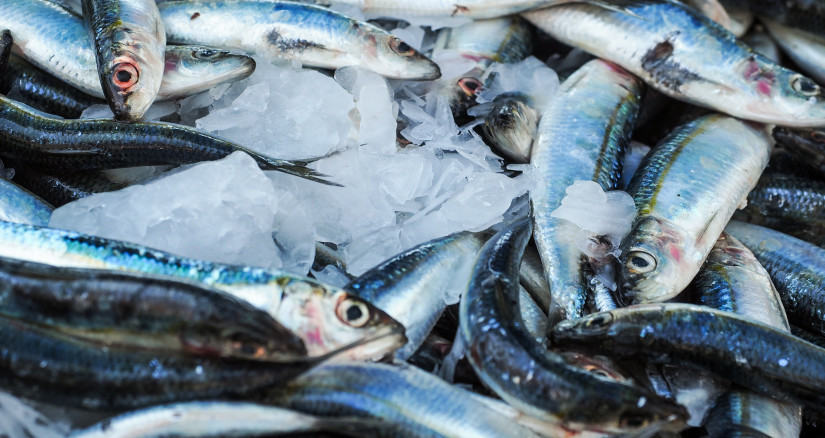
A Day on the Bering Sea
I could always tell what type of day we were going to have by the nausea in my stomach when I woke. The smell of bacon was in the air of my little stateroom that I shared with my Japanese technical representative. Nope, bad choice; bacon and toast were the worst on a sensitive stomach. Maybe they had some oatmeal in the pot, I had hoped. The cooked bacon wasn’t the only smell that morning, the daily fragrance of diesel and fish added to my morning aromas.
I could never get used to seas and waves over 25 ft. That is almost a daily event on the Bering Sea in January and February. The Bering Sea in late January was known to be some of the most unsafe places to fish; however, that was where the crabs were. Being a groundfish observer, inspection arm of the National Marine Fisheries Services, I had to be there, it was my job, so I had to get on with the day.
After four hours of sleep, I rolled out of bed and jumped into my crunchy pants. Pretty thick and crusty today. But it wasn’t my day for laundry so, I’d have to bear it for another two days. The previous 20 hours had been spent setting pots, giving them more than enough time to soak. I strode off to the galley, where the crew was already engaged in fighting over links, strips, and a pot of eggs. I grabbed a cup of coffee and some instant oatmeal, which I was happy about, and scooted along the rail head next to the crew around the little fixed table. This would most likely be the only hot meal of the day.

Pot/Gear storage
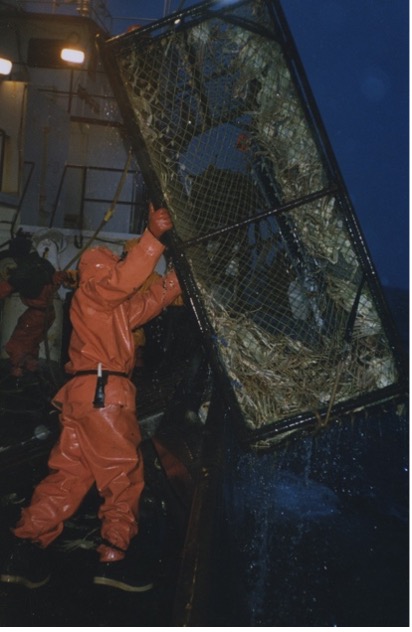
Hauling a pot in
They were a burly bunch, all seasoned crew, nine in total including the Japanese tech, Norio, and me. I was the greenhorn of the group, and they knew it. You couldn’t help but chuckle at their optimism. “Gonna pull in a big one today, Capt’n got the set”. Another would sarcastically spew, “Not the way you pull bait, John. Be lucky if we get half the pots in the water.” Laughter ensued, and on it went. About the time I got my 5th bite in a horn blew from on deck, 15 minutes to showtime, and it was time to suit up. We all chowed down a few more bites and scooted out from the table, leaving most of what was left for later, and piled into the wet room.

Doug (right), our Captain, and still one of the captains today!!
The wet room was a space between the interior and exterior of the boat where we would don and doff our rain gear, boots, and other gear. I, like the others, hopped into my rain pants and bibs, put on my boots and gloves, and threw my raincoat on overtop. The last part of the ensemble was our knife. One of the most important utility tools we had, it could cut you free of the line before you went over or help you separate your bait.

Aleutian Lady my first vessel
We poured out of the wet room, onto the deck of the Aleutian Lady. It was wet, always wet, but if you weren’t getting dripped on or splashed by a wave or hit by spray you weren’t fishing. It was also dark, but it was always dark in January. Dusk was barely four hours a day before it faded off into the pitch of the night. This made it extremely difficult to spot buoy markers or rogue waves for that matter. The Aleutian Lady, though she was primarily a crab boat in the winter months, was also used for fishing cod in fall and spring. At 160 ft long and roughly 35 ft wide, the deck was normally stacked with about 200 to 250 pots, each weighing 750 lbs., but today the deck was clear since they were all in the water from our last set. She could steam 19 knots at her best speed, not much in the way of space for nine crew but our only protection from the Alaskan winter for the next three months.
While cold, wet, and dark weren’t the best combination, it got worse when the wind hit you. At least 55 mph today I thought by the sting. The ocean spray would turn into snow and then travel horizontally as far as the sodium lamps would allow you to see. Everyone had long beards during those times, a bit of extra fur could mean the difference between frostbite and windburn. Icicles had to constantly be knocked off our beards as the spray would collect and freeze. I swear the horn in the morning wasn’t for us, it was for the gulls. Despite the dark, the wind, and the solitude, the one thing that was completely annoying was the gulls, big, ocean-going gulls. These were not the little ones you see inland or in parks. Hundreds of them would circle the boat daily waiting for a free meal from the leftovers of bait, crab, or fish we didn’t process. All in the excitement that our fishing was about to begin, their endless caw of the gulls would drive you to the point of near insanity.
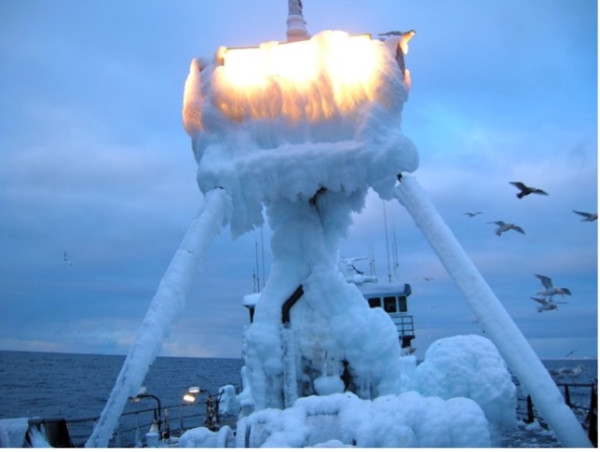
Isn't February fun
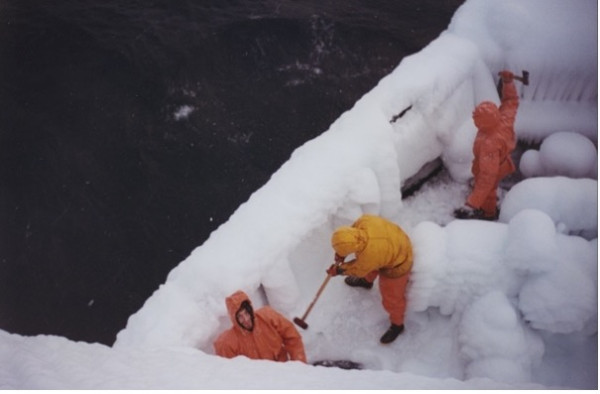
Bad day of icing
The deck was now in motion. The bait table and sorting table were set up. Booms and hydraulics were checked, and the pot launch cycled. Not too bad of a start on a pitch-black day and all that with only light icing. Icing occurred when the sea spray froze to the metal surfaces of the boat instead of draining back into the ocean. The tremendous weight could cause stability issues with the boat, and you didn’t want that when we were taking on 25-to-30-foot seas. Often, we would have to pause fishing and break the ice to regain stability using rubber sledgehammers, plastic mauls, baseball bats, and even axe handles. You tried not to use metal picks and bars as the lighter materials would absorb the shock better and not damage the boat. Temperatures of the Bering Sea in winter ranged from 26 to 32 degrees Fahrenheit if you were not in the ice pack. Going overboard was deadly in mere minutes. About that time was the first urge to discharge my breakfast, as I heaved what I had consumed John yelled, “Hey rookie, thanks for chumming for us!” The rest of the deckhands laughed. But the day had just started and I’m sure I would provide some more humorous moments throughout the day.
This is just a small excerpt from some of my time in Alaska aboard fishing vessels for crab, pollock, and cod, primarily. The takeaway from my description is that to be able to have the fish we and our pets eat, requires jobs that are not easy. Whether you’re a Pacific, Atlantic, or Gulf fisherman the job is long, hard, and very dangerous. There is no telling how many injuries or fatalities have occurred with this occupation that has been around since written history and longer.

Crew at work
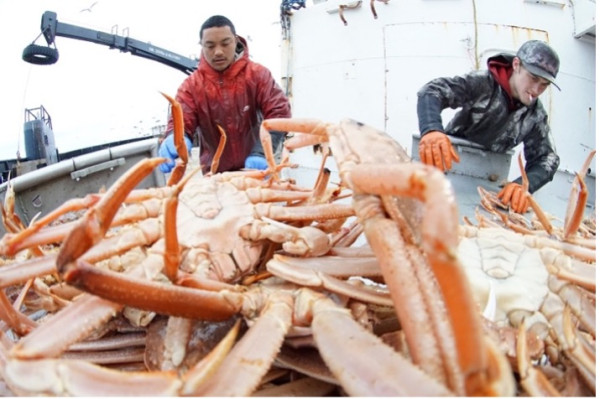
Close-up of snowcrab sorting

King Crab
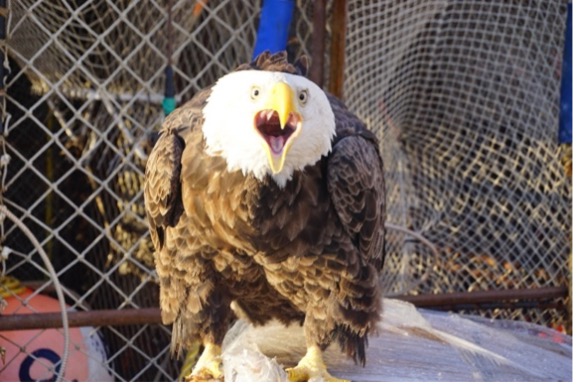
Looking for dinner
But how do the fisheries all work in the United States? What regulations are in place? Join me next time as I discuss Wild Caught Fish and US Regulations.
Follow us on LinkedIn for the latest updates on all things happening here at BSM Partners.
About the Author
August Konie has been a Food Safety, Quality and Regulatory Professional for over 30 years. He was worked in many sectors of the food industry including fisheries, beverages, poultry, pork and pet food, under both FDA and USDA regulatory oversight. As an active committee member in various trade organization for food and pet food organizations, he was successful of implementing new regulatory guidance. He has worked with various teams across Asian, Europe, North and South American on various food safety, quality and import/export concerns. He currently serves as the Principal of BSM Assurance overseeing FSQAR activities at BSM Partners.
This content is the property of BSM Partners. Reproduction or retransmission or repurposing of any portion of this content is expressly prohibited without the approval of BSM Partners and is governed by the terms and conditions explained here.